Key takeaways:
- Breakdancing, or b-boying, consists of various styles—toprock, downrock, freezes, and power moves—each with unique storytelling and emotional expression.
- Personal adaptation allows dancers to blend multiple styles, fostering authenticity and connection within the breakdancing community.
- Identifying styles involves recognizing distinct movements, musical influences, and cultural contexts that shape the dance experience.
- Personalizing a breakdancing style can enhance emotional connection through narrative, small tweaks in technique, and the influence of chosen music.
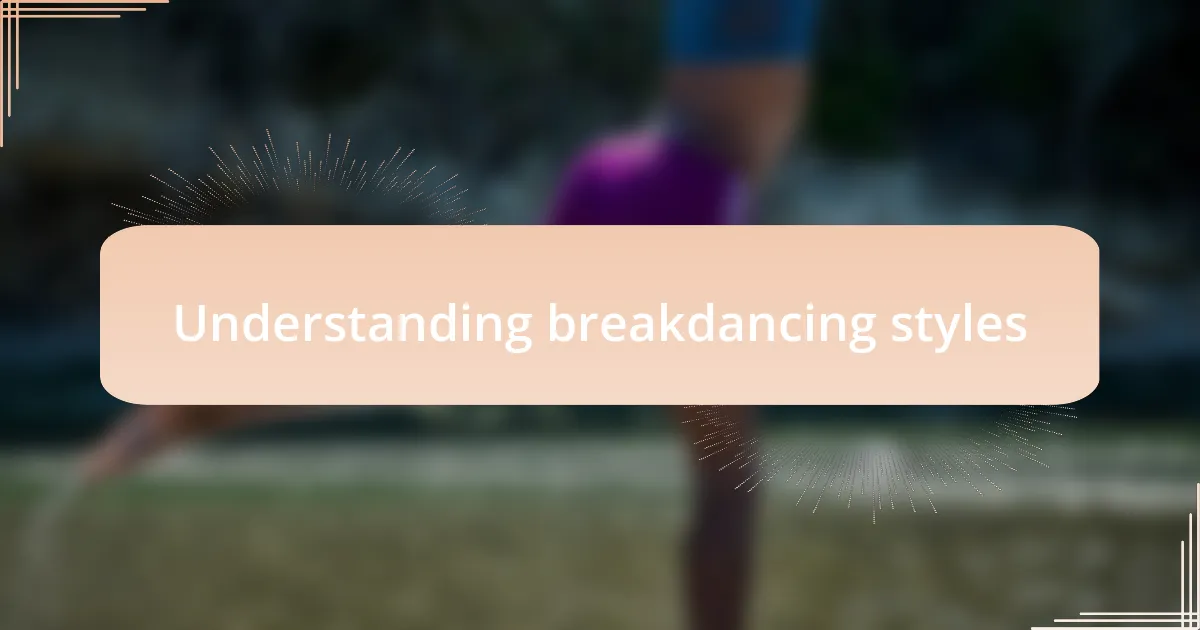
Understanding breakdancing styles
Breakdancing, or b-boying, comprises various styles, each filled with its own unique flavor and technical demands. I vividly remember my first encounter with power moves—those gravity-defying spins and flips that felt like pure magic. Watching someone execute a headspin left me both exhilarated and slightly intimidated, sparking a desire to understand not just the mechanics, but the emotion behind every move.
For me, learning about the foundational styles—toprock, downrock, freezes, and power moves—was akin to exploring different cultures. Each style tells a story; toprock is like a warm-up and sets the stage, while downrock brings you closer to the ground, immersing you in the music and rhythm. Have you noticed how different styles resonate with different emotions? When I’m feeling energetic, I lean into toprock, but when it’s more about expressing resilience, I find myself in a deep freeze, holding my position with determination.
As I delved deeper into the various styles, I also realized the power of personal adaptation. What works for one b-boy may not fit another, and that’s perfectly okay. I learned to blend elements from multiple styles to create something that felt authentic to who I am. This adaptability has not only enriched my dancing but also forged connections with others—because every b-boy journey is uniquely personal, yet we all share the same passion for movement and expression.
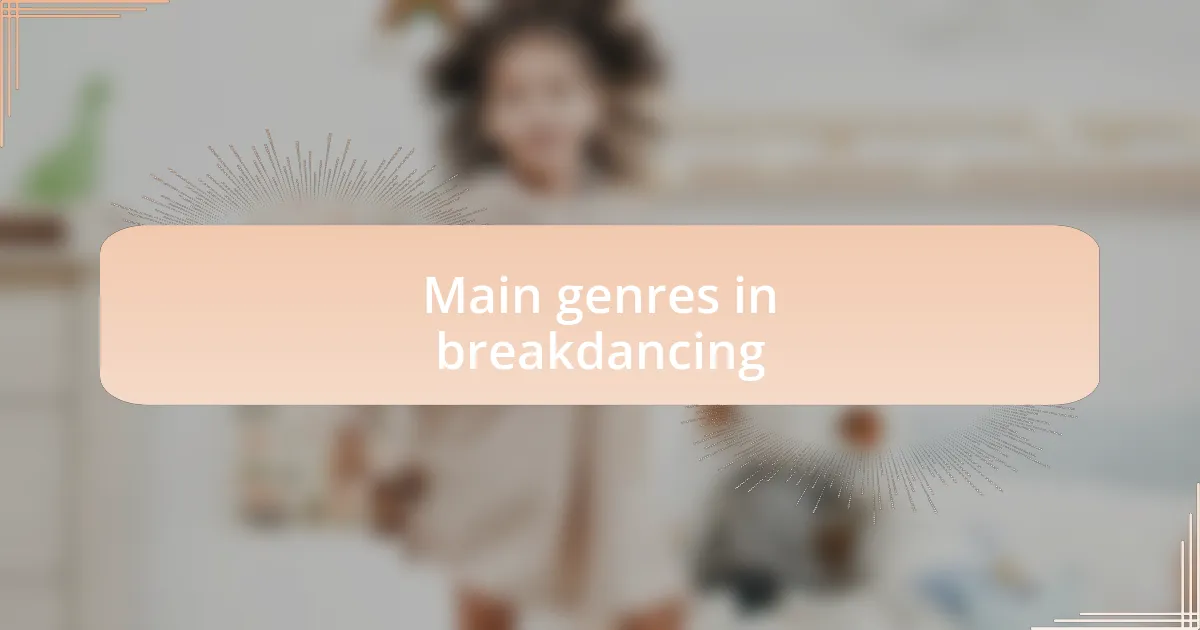
Main genres in breakdancing
When exploring the main genres in breakdancing, I’ve come to appreciate the diversity in styles, each offering a unique approach to movement. For instance, toprock serves as the energetic introduction where rhythm and footwork shine. I still recall the first time I hit a perfect toprock sequence at a jam; the audience’s response sent a surge of adrenaline through me, reminding me how powerful this style can be as a means of self-expression.
Downrock, on the other hand, pulls me into a world of grounded movement that feels so connected to the music. I once had a breakthrough moment while practicing a difficult transition from toprock into downrock; it clicked for me, and I felt more like a part of the rhythm than just an observer. Have you ever experienced that sensation of becoming one with the beat? It’s these little victories that build a dancer’s confidence and storytelling ability.
Then we have freezes, which are all about pausing in an impactful way, like punctuating a story with a dramatic flair. I remember nailing my first one-handed freeze—my heart was racing, and I felt an overwhelming sense of accomplishment. This style not only showcases strength but also invites viewers to pause and reflect on the art of the dance. Each genre, with its distinct characteristics and emotional resonance, invites us into a deeper connection with both ourselves and the community around us.
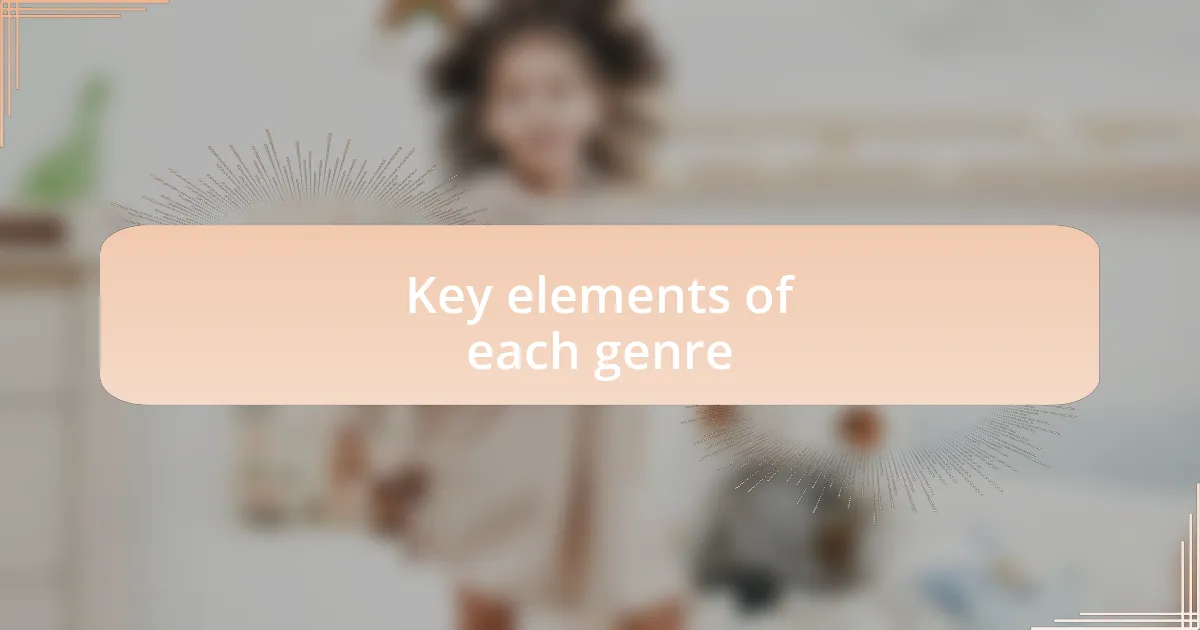
Key elements of each genre
When diving into the world of power moves, I find that the sheer athleticism involved is both thrilling and daunting. The first time I attempted a windmill, I can still recall the mixture of excitement and fear coursing through me as I spun for what felt like an eternity. These moves require not only strength but also a deep understanding of momentum; have you ever captured that exhilarating rush of defying gravity? It’s a dance with physics, where every movement is a calculated risk that pulls you into the spotlight.
Despite their complexity, footwork dances showcase a dancer’s agility and creativity in ways that often leave me in awe. I remember watching a fellow B-boy seamlessly weave between intricate patterns during a battle—each step telling a story and offering a glimpse into his personality. The ability to control and manipulate movements while still keeping them fluid is what sets footwork apart; it’s like conversing with the music. Don’t you love how a dancer can communicate emotions through their feet alone?
Finally, transitions are the unsung heroes of breakdancing genres. They’re the moments that connect one style to another, creating a narrative thread throughout the performance. I once worked tirelessly to smooth out the transition from toprock into downrock, and the breakthrough moment left me on a high. It’s fascinating how these subtle movements can change the whole vibe of a piece, isn’t it? Each transition captures the heart of storytelling in dance, revealing a dancer’s inner dialogue with every shift.

How to identify different styles
To identify different breakdancing styles, it’s crucial to pay attention to their distinct characteristics. For instance, I remember the first time I saw a locking style performance; the sharp, staccato movements felt electrifying. Can you feel the rhythm just by watching? Each style often has telltale signs, like the way a dancer emphasizes funk in locking or the fluidity of the transitions in vogueing.
Another key aspect is the music that accompanies each genre. When I dance, the type of beat heavily influences my movements. I recall a battle where the DJ dropped an old-school hip-hop track, and the way everyone adjusted their style on the spot was astonishing. The pulse of the music really guides the expression, doesn’t it? Recognizing these musical cues can greatly enhance your ability to differentiate between styles.
Lastly, consider the culture surrounding each genre. I remember the first time I participated in a cypher for freestyle hip-hop; the vibe was so welcoming and supportive, contrasting sharply with the competitive nature of battles in breaking. Engaging with the community helps you appreciate the nuances of each style, making it easier to identify and connect with them. Isn’t it amazing how atmosphere can influence the way we dance?
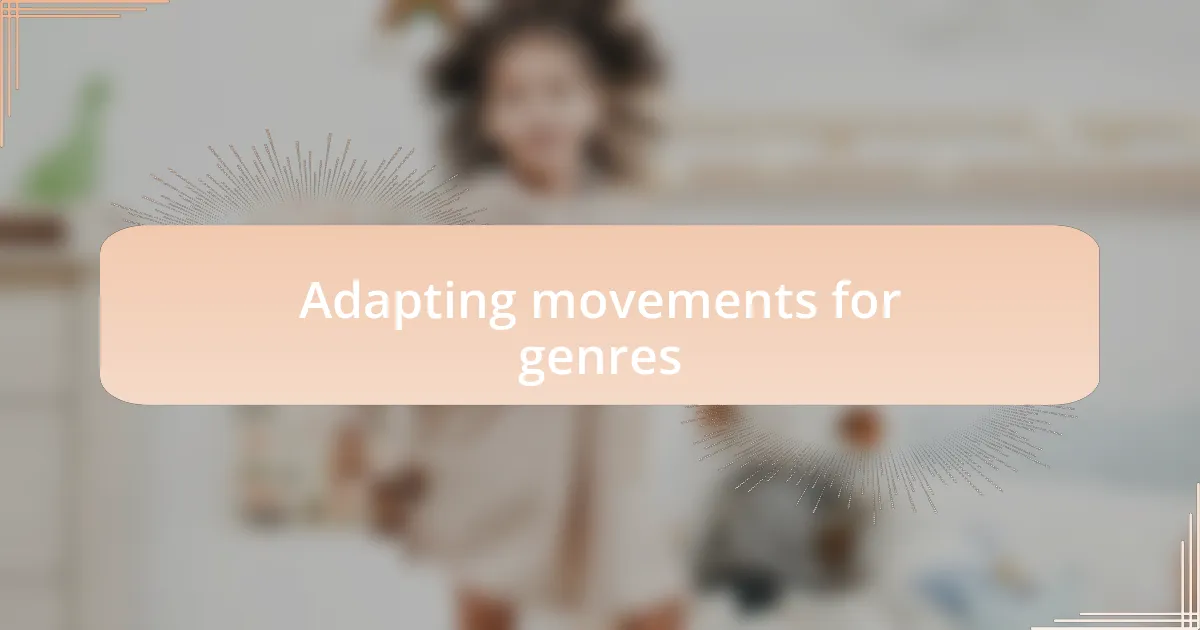
Adapting movements for genres
Adapting my movements for different genres was like learning a new language. I vividly recall my first experience trying to incorporate elements of popping into my breaking routine. The isolation of my muscles felt completely foreign at first, but once I started to understand how to punctuate my freezing moments with sharp pops, everything clicked. Isn’t it fascinating how our bodies can transform with just a slight shift in the movement intention?
When I transitioned into house dance, the fluid, rhythmic footwork challenged me to rethink my usual dynamics. I remember feeling the floor beneath me urging my feet to glide and shuffle, rather than the hard-hitting steps of breaking. Learning to let go of the rigid structures I was used to and embrace the smoothness felt incredibly liberating. Can you imagine how it feels to let the music lead your body instead of trying to control every move?
I also found that adapting to krumping was an emotionally charged experience. The explosive energy and raw expression required me to tap into deeper feelings, releasing frustration and passion through exaggerated gestures. I once stepped into a cypher where emotions ran high; it was exhilarating to channel that intensity into my movements. Have you ever felt so connected to the music that each move seemed to resonate with your heartbeat?
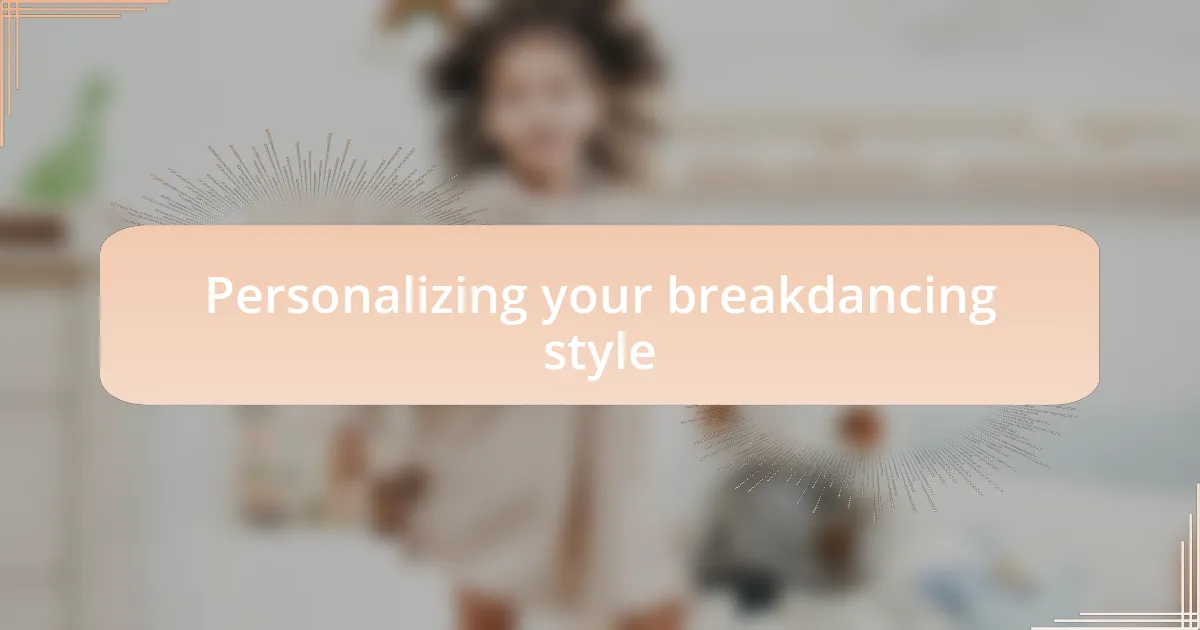
Personalizing your breakdancing style
Personalizing your breakdancing style involves a deep dive into what resonates with you on a personal level. I remember when I first started to experiment with incorporating elements from contemporary dance into my breaking. It wasn’t just about the moves; it was about creating a narrative in my performance. I often ask myself, how can my story be told through my body? This led me to blend sharp, defined moves with softer transitions, giving my style a unique duality that felt authentically me.
As I began to explore the nuances of different styles, I noticed that even small tweaks could significantly impact my overall expression. During one practice session, I played around with extending my arms more gracefully during freezes. This small adjustment made me feel more connected to the music and the audience. Have you ever felt the difference in energy when you allow your limbs to extend beyond your usual boundaries? That moment transformed my approach, reminding me that personal style is not just about the tricks but about how I convey emotion through every gesture.
Over time, I realized that my connection to the music directly influenced how I personalized each routine. I often find myself reflecting on the stories behind the songs I choose. One night, I danced to a track that spoke of resilience and strength. The beats fueled my movements, and I poured every bit of emotion into my spins and freezes. Can you remember a time when a song moved you to express something deeper in your dance? It’s in these moments that our unique styles really flourish.